How to Visit the Colosseum in Rome (for First Timers)
Every time we set eyes on the Colosseum in Rome, we’re instantly reminded just how impressive a feat it is (though, we’d also say that the Forum is arguably more impressive if you consider the scale).
Can you imagine building that two thousand years ago without modern technology? It’s madness.
A visit to the Colosseum is going to be a cornerstone of most people’s first trip to Rome, and for good reason.
In combination, the Colosseum and Roman Forum (they’re in the same archaeological complex) are the best window into the era where Ancient Rome ruled the Mediterranean.
However, we also know that there are certain things you’re going to need to know to make the most of your trip, and they’re things you couldn’t possibly know unless you had already been there yourself (that’s where we come in – we love being useful!).
As an example, the fact that there’s essentially no shade in the Forum. There’s a world of difference between a visit midday in the hot summer months and taking advantage of the cooler temperatures early in the day.
We’re here to give you all the information we think is important so that your visit is as incredible as ours have been.
I, Matt, have now been to the Colosseum and Roman Forum four times each (it never gets old to me!), including two times in the past two years.
I’ve done them both independently and as part of a guided tour (two and two), which gives me the perspective and experience to make recommendations on how to make the most of your time (and money).
In this guide, we’re going to use our experience to give you everything you need to know to visit the Colosseum for the first time.
In the (long) guide below, we’re going to go through the different pieces of the complex, what to prioritize (you won’t be able to see it all!), how to get tickets, and what to expect when you’re there.
By the end of the guide, you’ll have all the information you need to plan your own visit (and, most importantly, secure tickets or a great guided tour).
Sound good to you? Let’s get into it.

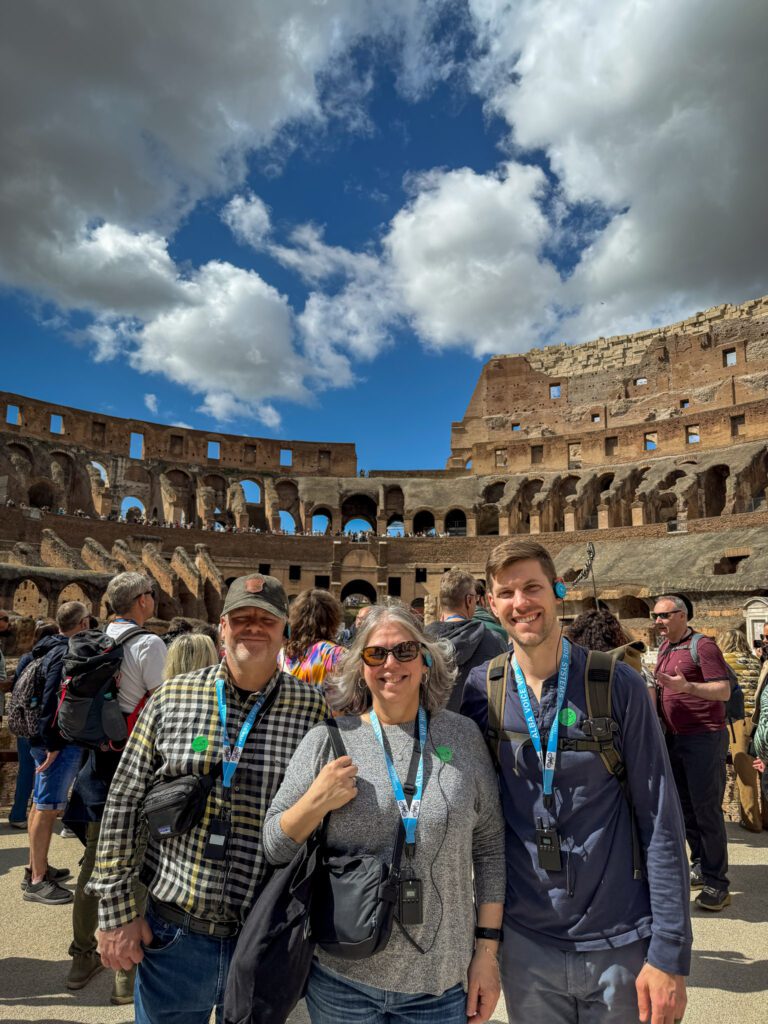
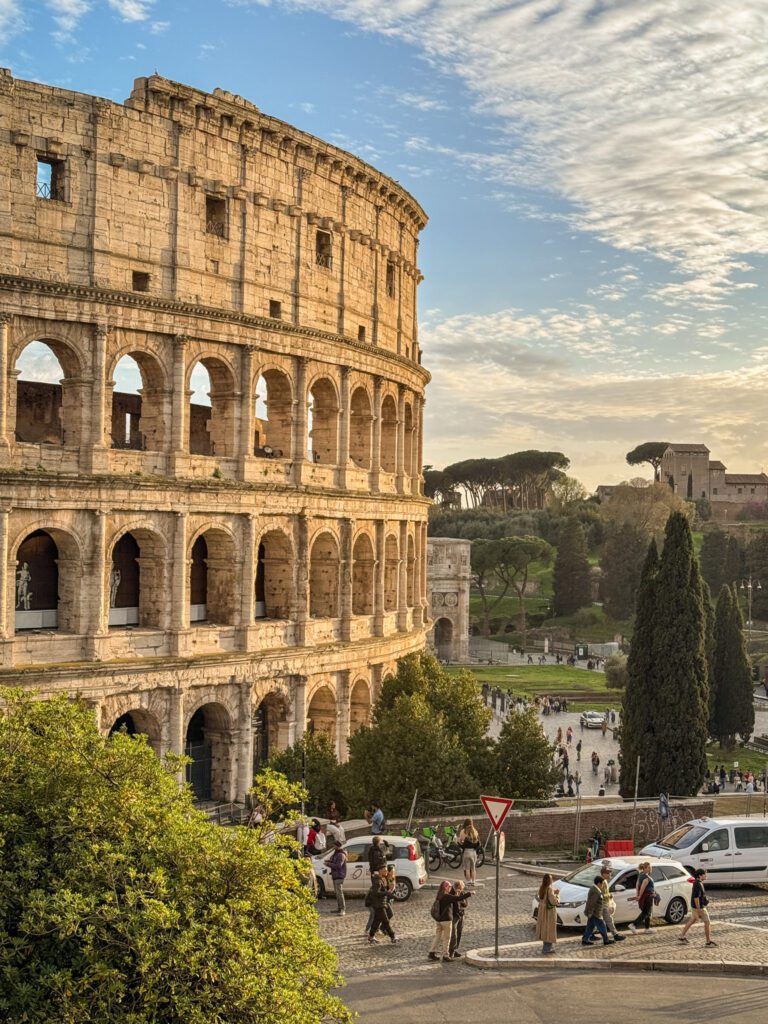
Disclaimer: Some of the links in this post, like hotel links, are affiliate links, meaning at no additional cost to you, we make a little bit of money if you click through and book. That being said, we would never recommend something to you that we don’t stand behind 100%.
What, Exactly, is the Colosseum?
The first thing to know here is that the Colosseum and Roman Forum are part of the same complex (the Parco Archeologico del Colosseo) and your ticket for the Colosseum also includes entry to the Roman Forum.
They’re right next to one another, with the entrances facing each other across a (busy) pedestrianized street.
However, despite being adjacent to one another, they actually served different purposes in Roman life, which is why we’re going to talk about them separately in terms of what their function was two millennia ago.
First, let’s talk about the Colosseum.
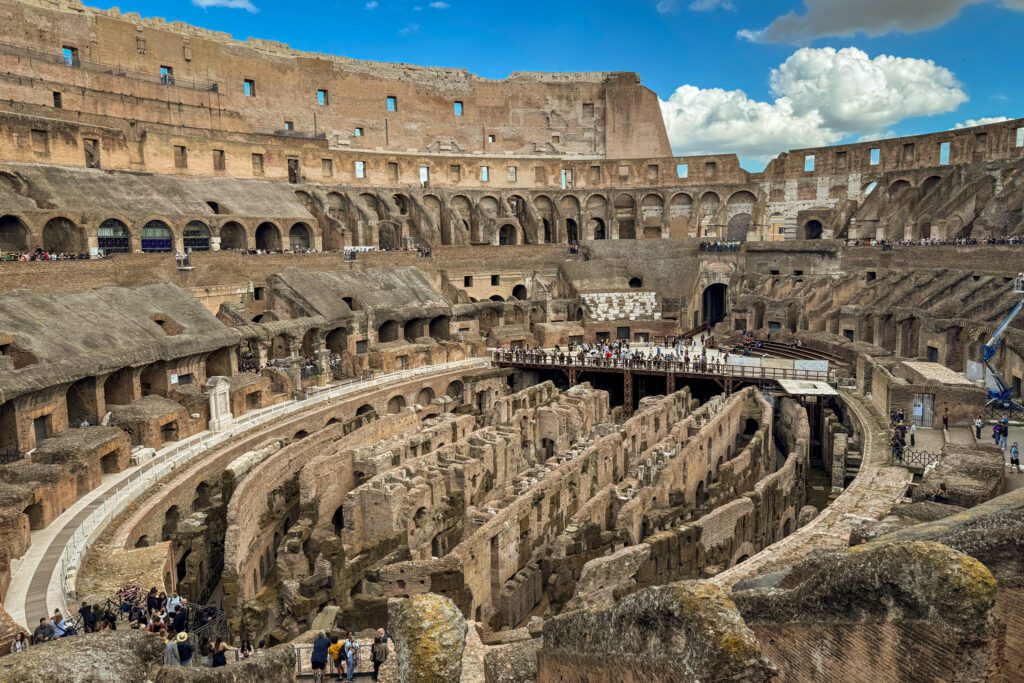
The Colosseum is a massive elliptical amphitheater that stands nearly 50 feet high (roughly five stories), and is more than 600 feet long at its longest point.
At its core, it is essentially a huge stadium that was built to put on games in Rome, mostly to appease the working class Romans and keep them happy with the administration in power.
Coming from an American perspective – particularly being from the west coast, where our cities are MAYBE 200 years old – the depth of history and culture that exists within this little complex is mind boggling.
Thousands and thousands of years old, some of the structures have been repaired, sure, but the fact that anything at all is standing here after millennia brings the grandeur and impressiveness of the Roman empire into full focus.
One of the most impressive things about the Colosseum, at least to us, is the fact that it was completed in eight years. It was started by Emperor Vespacian in 72 CE, and finished in 80 under Emperor Titus.
It was built to keep the common people of Rome happy after Emperor Nero had seized this land to expand his personal palace and erect a giant statue of himself.
Not a great look. Think of it as returning the power to the people.
You know what the common people loved? Games!
Gladiator battles, great hunts, battle reenactments, and many other types of games were held here.
It would be a day (or several days) full of different events, with hunts in the morning, public executions at lunchtime, and the main event – the gladiators – closing out the show.
One thing we picked up on a guided tour we did a few years ago is the fact that, contrary to what pop culture would have you believe, the vast majority of gladiator games were not deadly.
They were more akin to boxing or wrestling matches with swords than a fight to the death in most cases. Gladiators were seen as big investments at that time, and you probably wouldn’t want your big star to die during one of their performances if you could avoid it.
In later times, it fell into disrepair, and some of the stone was, uh, repurposed elsewhere in Rome (read: stolen to use elsewhere, something that Italians have been extremely good at throughout history).
What About the Roman Forum?
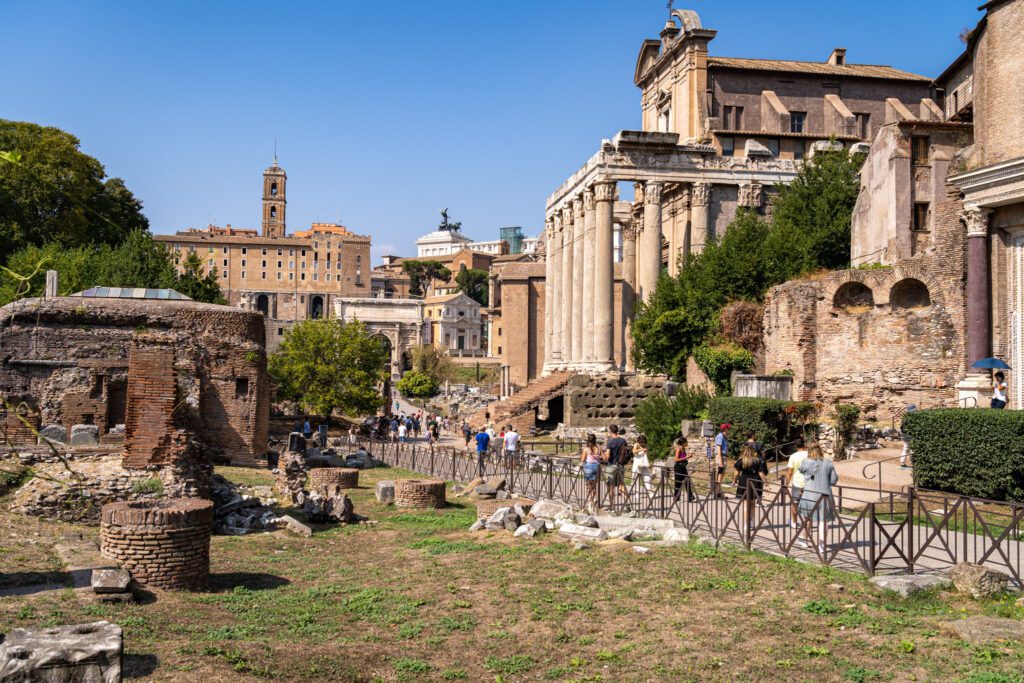
The Roman Forum is a completely separate beast from the Colosseum, and is arguably the most important piece of Ancient Rome. But, for some reason, only a fraction of visitors to the Colosseum actually go to the Forum.
We’re here to tell you that you should absolutely go to the Forum!
It’s an incredible piece of history, with buildings that are 2,000 years old (or were before they were torn down, their materials – marble, travertine, etc etc repurposed to build other things in Rome).
While the Colosseum is, perhaps, the more famous of the two attractions in modern times, the Roman Forum was there first, and served as the political, religious, and economic center of the Roman Empire.
It’s set in the valley between the Palatine and Capitoline hills (two of the most important of the seven hills in Rome).
Today, the Roman Forum is largely in ruins, with a few notable exceptions that help give you an idea of the scale of the buildings here (impressive for 2,000 years ago).
There is a lot to see here, and this is where a guided tour (we’ve done this excellent tour…twice) is going to help you make sense of what you’re looking at.
An alternative would be Rick Steves’ free audio tour (it’s called the “Roman Forum tour” and you have to download his app to have it available offline), which we’d also recommend (especially for the price of…free).
We’d make sure not to miss these specific spots (though, of course, there are plenty of other things to see):
The Temple of Venus and Rome: A beautiful temple that we now believe was the biggest temple in Rome. It used the rare Egyptian red marble, Porphyry, which I always get a kick out of because it’s the equivalent of using diamond or solid gold today.
The Arch of Titus: A triumphal arch that you will walk by at some point because it’s right in the middle of the main path through the Forum. It was built in 81 CE to commemorate the fall of Jerusalem (which had risen up in rebellion against Rome).
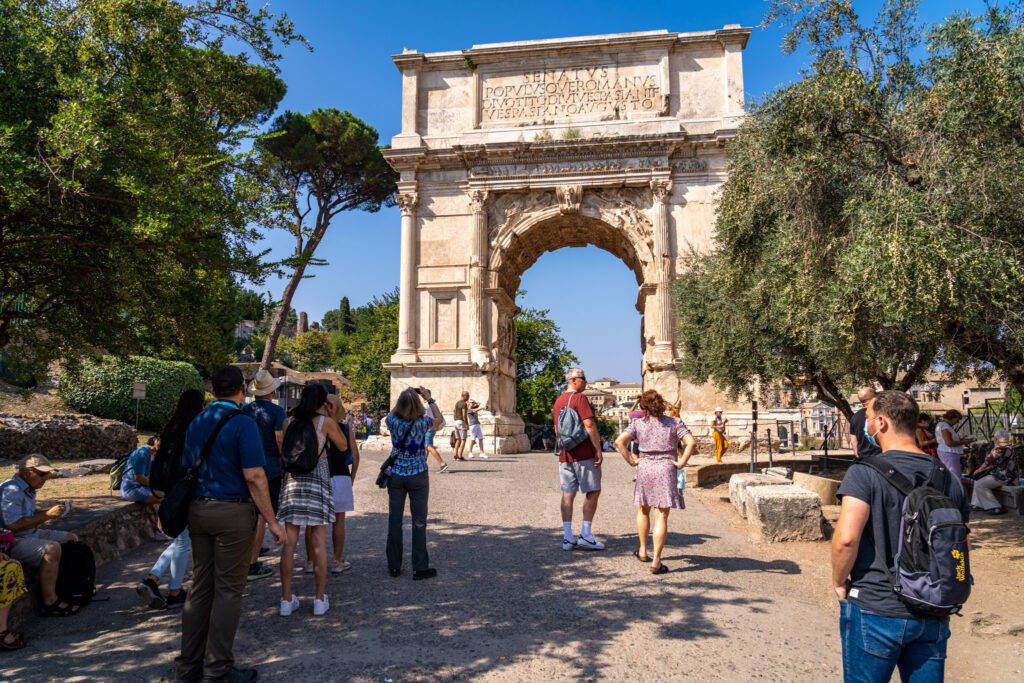
Make sure to look at the inside of the arch to see the art that shows the triumphal procession bringing back all the artifacts they…acquired… in Jerusalem.
The Viewpoint: A great view of the Forum from above (here on Google Maps) that looks straight across the valley to the north at the massive Basilica di Massenzio.
It’s very exposed, and you have to do some climbing to get up to it, but it’s worth it, we think.
Here are some pictures so you can decide for yourself.
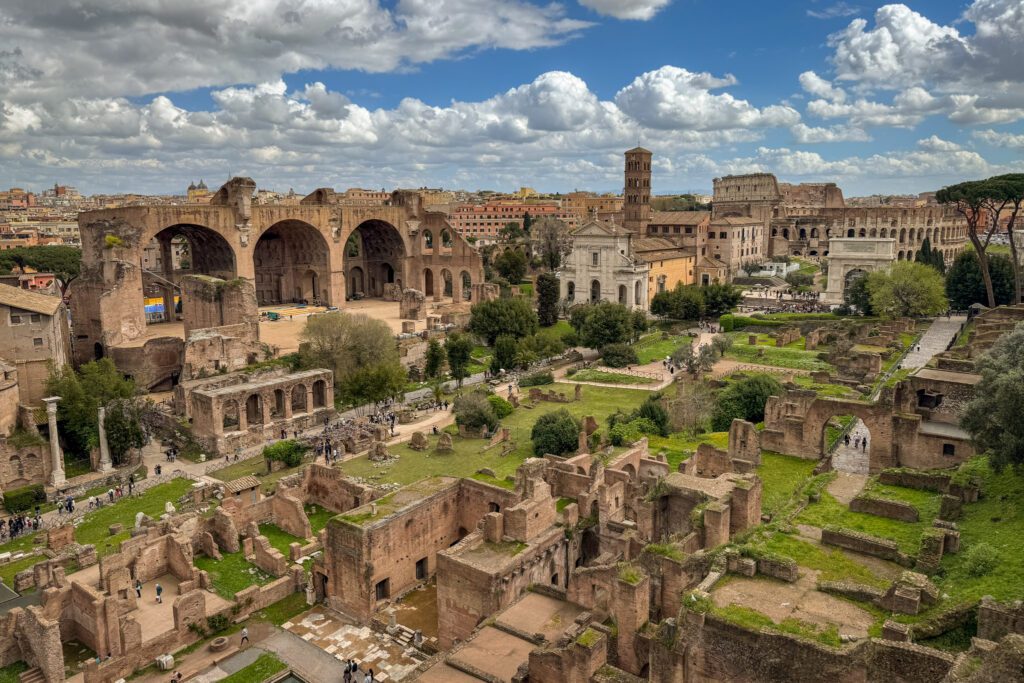


The Curia Julia: The new Senate house started by Julius Caesar after the old Senate house burned down).
It’s also worth visiting the Chiesa di Santa Maria Antiqua, if you can, with its old frescoes that are one of the oldest pieces of evidence of the Christian influences in Rome (it was built in the 5th Century CE).
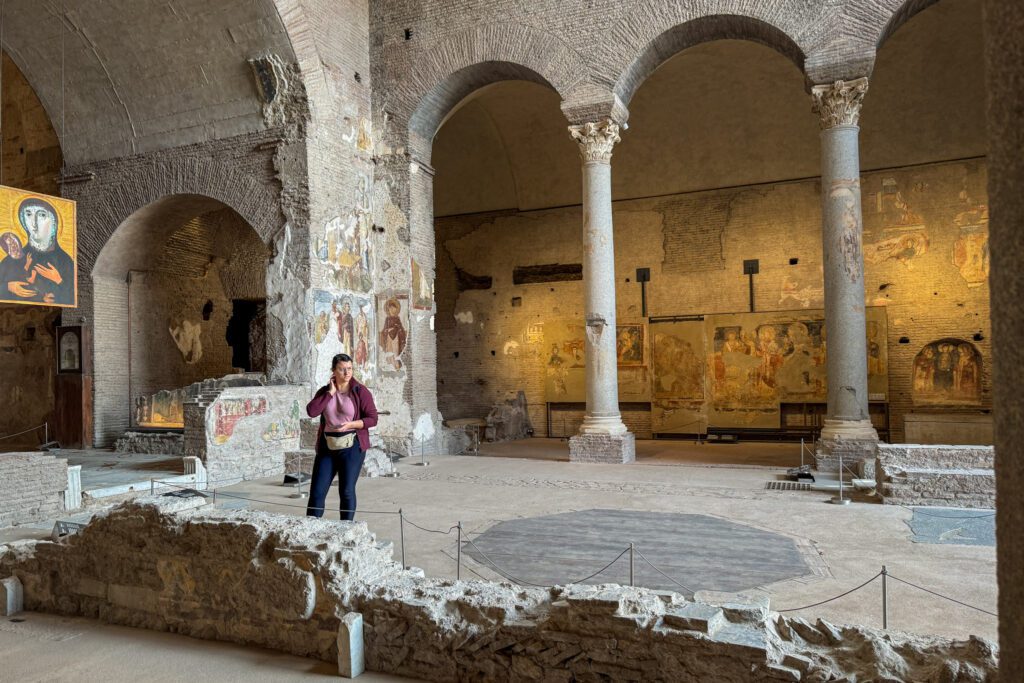
The church was buried for 1,000 years and only uncovered in the 20th Century.
You can only visit with a ticket that includes access to the “Super Sites,” and while I (Matt) thought it was cool on my last trip (and I had never heard of it before that trip), I wouldn’t go out of my way to get the Super Sites ticket just for this.
I’d only visit if you happen to choose a ticket type that includes access to the Super Sites (more on those ticket types below).
Should You Do a Tour of the Colosseum and Roman Forum?
Obviously, the answer to this question is going to depend on a bunch of different factors – your timing, budget, and patience for learning about history.
In general, over the past several years, I’ve come to the realization that it is almost always worth the extra money to have a local guide show you around a place or city.
Here’s an example to illustrate my point.
Have you ever been to a “local market” in a city you’re visiting? On our first trip to Mexico City years ago, we went to a couple of them completely on our own.
Which was fine – we basically walked around the market, admiring all the amazing fresh produce and watching people make tortillas for a bit before deciding to move on. It took all of about 15 minutes.
On our second trip to Mexico City, we did a cooking class that involved an hour long deep dive into that market with a local.
We learned about all sorts of peppers that we’d never heard of, tried some chocolate, fruits, and chapulines that our guide recommended, and discovered the deliciousness that is tamales dulces (“sweet tamales”).
It was a COMPLETELY different experience, and the context that our guide was able to bring to the table – context that we never, ever would have gotten on our own – was invaluable, and led to a much more memorable experience that we still talk about (clearly, because here I am talking about it).
We have a strong opinion here, mostly informed by the fact that we did an amazing tour of the Colosseum with our favorite Italian tour company, Walks of Italy (you can read all about it here) where we learned that some (really, most) of the things we thought we knew about the Colosseum were actually just fairy tales.
No, the battles weren’t gruesome and bloody. No, they didn’t execute Christians en masse. No, they didn’t have naval battles inside the Colosseum (for the most part, anyway).
Matt actually returned to Rome with his mom and uncle this year and did the same exact tour (basically), and it was equally impressive and covered new ground in the Forum, even for him.
The richness of the detail and context our guide was able to bring to our understanding took the experience to the next level for us, and we’d highly, highly recommend investing in a tour.
Without those stories, it’s hard to understand the significance of what you’re seeing, especially in the Forum, which is mostly ruins at this point.
Remember, we had both experienced the Colosseum before. MULTIPLE TIMES before that eye-opening tour, and we still learned a ton.
That, my friends, is the power of taking a tour with a guide who actually knows what they’re talking about. You’ll get to go a level deeper and learn about the structure beyond the fairy tales and myths that have been perpetuated for decades.
Without that context, you’ll probably be walking through the Roman Forum and seeing some old, broken buildings, which will take you all of 30 minutes before you’re ready to move on.
We would say that, if you only have time, budget, or interest for one guided tour while you’re in Rome, this is the one we’d choose (over the Vatican Museums) because it will help paint a clearer picture of the grandiosity of this part of Rome 2,000 years ago.
We have personally done both this tour of the Colosseum and Roman Forum with Walks of Italy AND this tour that includes the Arena Floor, which is a cool perspective of the Colosseum from below that you only get with that special arena floor access (not included in the basic Colosseum visit).
Both were excellent, and we can’t recommend them highly enough. Which you choose comes down to whether or not you value the access to the floor (which comes with a price premium, as you might imagine).
If a tour isn’t in the cards for you, let’s talk about getting tickets for the Colosseum on your own.
Visiting the Colosseum (& Forum) Independently
This is, perhaps, the most important part of this entire guide. Tickets for the Colosseum and Roman Forum are extremely competitive, and they absolutely will sell out (especially the underground tickets, which are in high demand and low supply).
The only question is when (for peak season, it’s FAST, for November to March it’s a little less competitive).
We STRONGLY recommend purchasing your tickets well in advance.
They go on sale 30 days in advance (more detail on this below), and the most desired types of tickets sell out within a few minutes if it’s peak season.
You can technically buy them on the day of, but the line will be long and you will likely have to wait for an hour or more to get them (and they might end up being sold out by the time you get to the front of the line, depending on the day).
If you’re absolutely set on seeing the Colosseum while you’re in Rome, you’ll want to book them as soon as you are able to, and plan the rest of your Rome itinerary around that reservation.
Buying tickets in advance will give you access to the 8:00am and 8:30am entry slots.
The Colosseum and Roman Forum are going to be PACKED from roughly 10:00am to 4:00pm, which is when the vast majority of people visit.
Getting in there early will be a much more pleasant experience, especially for that first hour or two.
That’s not to say there will be nobody there at 9:00am, but the crowds are noticeably thinner.
If you don’t get those early entry spots, my guide for my last tour told me that a close second in terms of crowds is the couple of hours before closing.
Look at the 5:00pm entry slot for that – the complex is open until 7:15pm, so you’ll have roughly two and a half or three hours to cover everything (which is the right amount of time for most people, we think).
When to Book Your Colosseum Tickets
Tickets for the Colosseum and Forum go on sale 30 days in advance, to the day.
They do sell out, particularly during high season, so you’re going to want to secure them as soon as possible (ideally when they go on sale to make sure you get a morning or afternoon slot).
At the time of writing, they are released at 08:45 Central European Time (2:45am EST, 11:45pm PST), which is… inconvenient if you’re coming from North America.
If you want the more competitive ticket types – the underground or attic tickets – you’re going to need to be ready right when they go on sale (and even then, be prepared to miss out because they are that competitive).
The first entry of the morning is similarly competitive, and if you want to be one of the first people in the Colosseum in the morning, you’ll want to be ready to go when they go on sale.
Generally speaking, though, we think you should be okay booking more basic tickets when you wake up – especially if you’re good with an afternoon timeslot.
Even right now in August (which, I concede, is a weird time to be looking because it’s August in Rome) there is plenty of afternoon ticket availability for the next four weeks.
Now, let’s go through securing your tickets.
Getting Tickets for the Colosseum (Step-by-Step)
Look, like many things in Italy, the Colosseum website doesn’t exactly function perfectly.
To write this guide, I went through the process (not at 11:45pm PST, though) to see where the pain points would be, and realized that the entire process from start to finish is basically just one big pain point (especially if you want to get the most competitive ticket types).
The first thing you need to do is make sure you’re in the right place. Make sure you go to the official ticketing site (not the main official site), which works at all hours.
If you’re buying tickets for your visit, you’re going to want to be prepared for three things:
- An absurdly early wake up call (if you’re on the east coast in North America, or a late night if you’re on the west coast)
- A large dose of frustration due to a website that inexplicably crashes regularly (half the time I tried to access it for compiling this guide, it wouldn’t even load)
- The fact that you might not get your exact preferred ticket or timeslot (especially if you’re coming in the summer)
All that being said, it’s totally reasonable to get tickets for your visit if you’re on the website around the time they are released (though you might not get the underground tickets, which sell out almost instantaneously).
That, after all, is why we wrote this guide: to help you figure out how to navigate this confusing process!
First of all, I can’t stress enough that you need to make sure you are looking at the official ticketing website (the regular website is inexplicably down at all sorts of random hours).
From there, click on the “Individuals” tab, which will bring up a page with many, many different ticket options that all include something slightly different.
Now, we need to pause here because you need to know a bit about the language they’re using to understand what the different ticket types are referring to.
They use four terms to talk about the different parts of the Colosseum:
“The Colosseum” refers to the main entry areas to the Colosseum (e.g. the basic ticket that covers the first and second levels).
“The Arena” refers to the floor of the Colosseum, which we think is cool because it puts you in the shoes of a gladiator and you get a perspective on the sheer scale of the building.
“The Attic” refers to the fourth and fifth levels of the Colosseum, which you take an elevator to reach and gives you a view of the Colosseum from above.
“The Underground Levels” refers to the network of tunnels below the floor of the Colosseum, which is interesting and gives you a good perspective on how they went about producing the games that took place here.
Back to the ticket types – there are a lot of them!
However, we’ve gone through them and think there are really only three that you should consider. They are:
“24h – COLOSSEUM, ROMAN FORUM, PALATINE”: This is the basic ticket and allows you to enter the first two floors of the Colosseum at the selected time, then enter the Forum any time over the next 24 hours.
This ticket has the most availability, and when I looked in mid-August, there were plenty of tickets available any day in the next 30 days.
“FULL EXPERIENCE TICKET WITH ENTRY TO THE ARENA OF THE COLOSSEUM”: This ticket includes the main entry to the Colosseum and entry to the Arena floor (which as we mentioned above is pretty cool and is something we’ve only done on our last trip to the Colosseum).
You can then enter the Forum any time over the next 24 hours. There were also plenty of afternoon tickets available for this when I looked in mid-August.
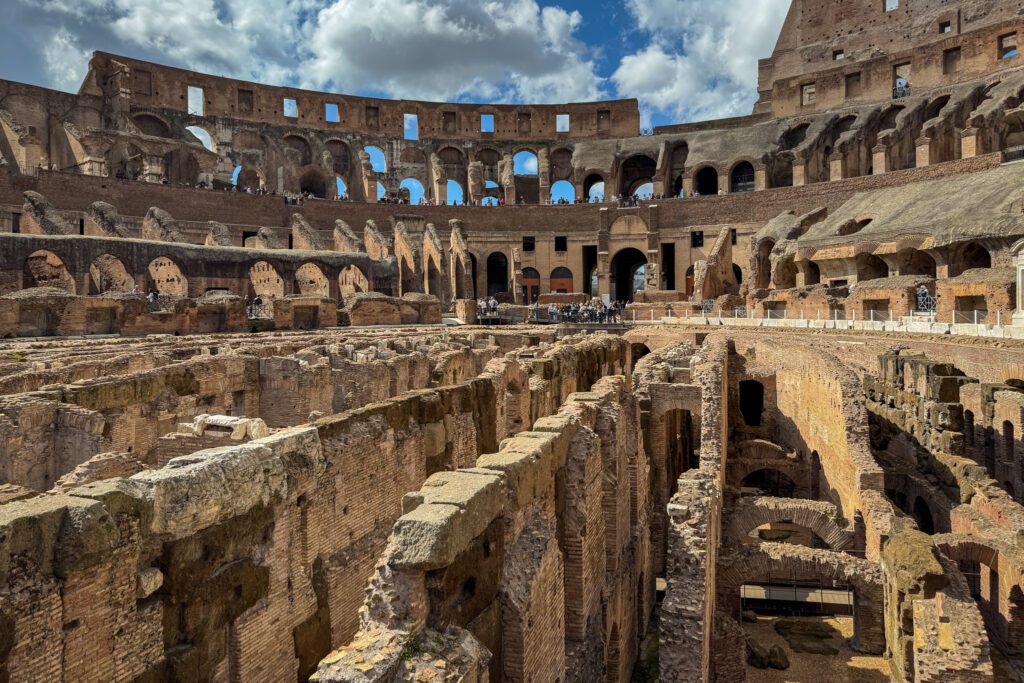
“FULL EXPERIENCE – UNDERGROUND LEVELS AND ARENA”: This ticket includes entry to the main area, the arena floor, AND the underground tunnels below the floor (plus the same Forum entry privileges as other ticket types).
The underground portion is cool, but the nature of the narrow walkways means that the number of people is strictly limited, and it’s hard to get tickets.
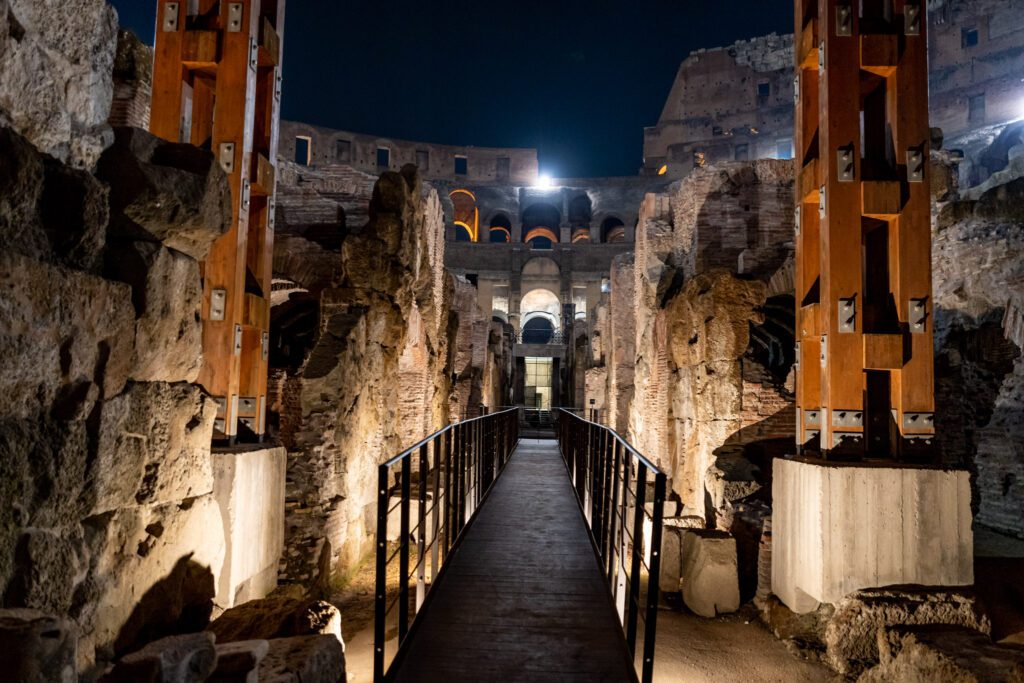
Other ticket types include:
“24H ONLY ARENA” (only includes the arena floor, not the upper levels of the Colosseum),
“FORUM PASS SUPER” (only includes entry to the Forum, not the Colosseum)
“FULL EXPERIENCE TICKET WITH ENTRY TO THE ATTIC OF THE COLOSSEUM” (we’d strongly recommend the arena floor over the attic)
Again, we’d prioritize all three of the ticket types in the bullets above over any of these options.
If the Attic sounds cool to you, you should know that the Attic is equally as competitive as the Underground tickets, so go in with the right expectations.
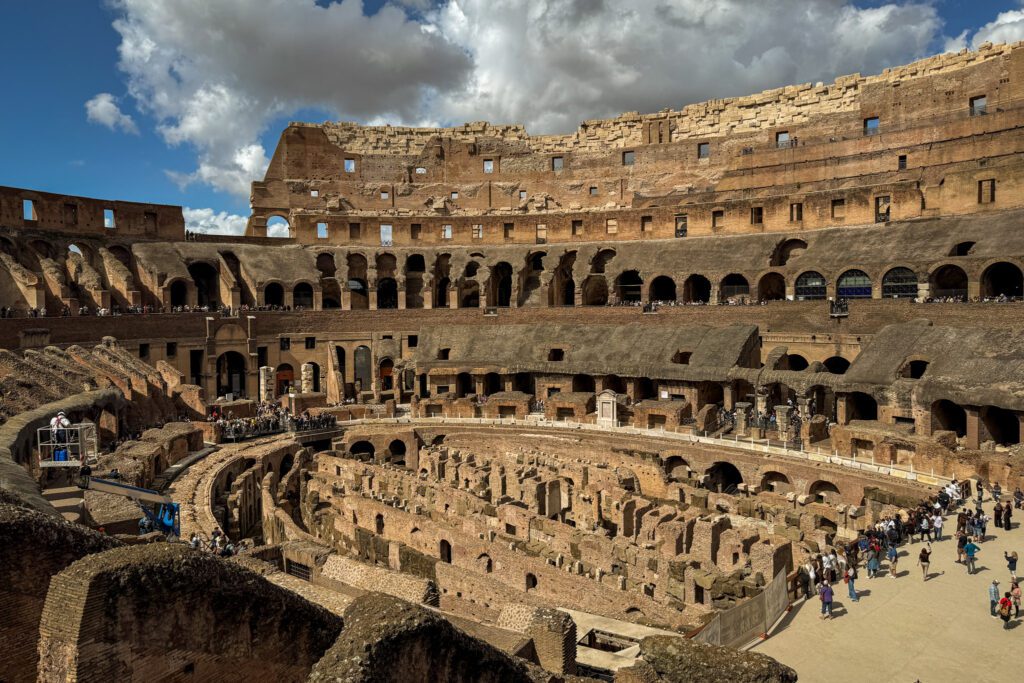
For each ticket type, you’ll select a date and time – this is the day and time you must enter the Colosseum – and then you’ll be able to go to the Forum and other attractions within a certain time period after that timeslot (usually 24 hours).
What to Do if You Can’t Get Tickets
If, for some reason, you are not able to secure tickets for your preferred date and time, you have a few options (so don’t panic!).
First, look at the guided tours available through the Colosseum itself, which can be a bit more expensive, but sometimes have more availability. You can find those here (you click “educational tours” from the main ticketing page).
Second, look at ticket resellers that advertise on places like Get Your Guide.
Oftentimes they have access to more tickets. It sucks since they’re essentially scalpers, but it’s a way to get tickets.
Be careful and read reviews to avoid getting scammed – we linked the official Get Your Guide tickets above, and they appear to be the basic Colosseum ticket that we described above.
Third, book a guided tour through a reputable company. We’re big proponents of Walks of Italy – a tour company we’ve done ~8 tours with around Italy at this point.
We’ve done multiple versions of their Colosseum + Forum tours, and we’d recommend the Colosseum Arena Floor Tour, which includes access to the arena floor and the main area of the Colosseum.
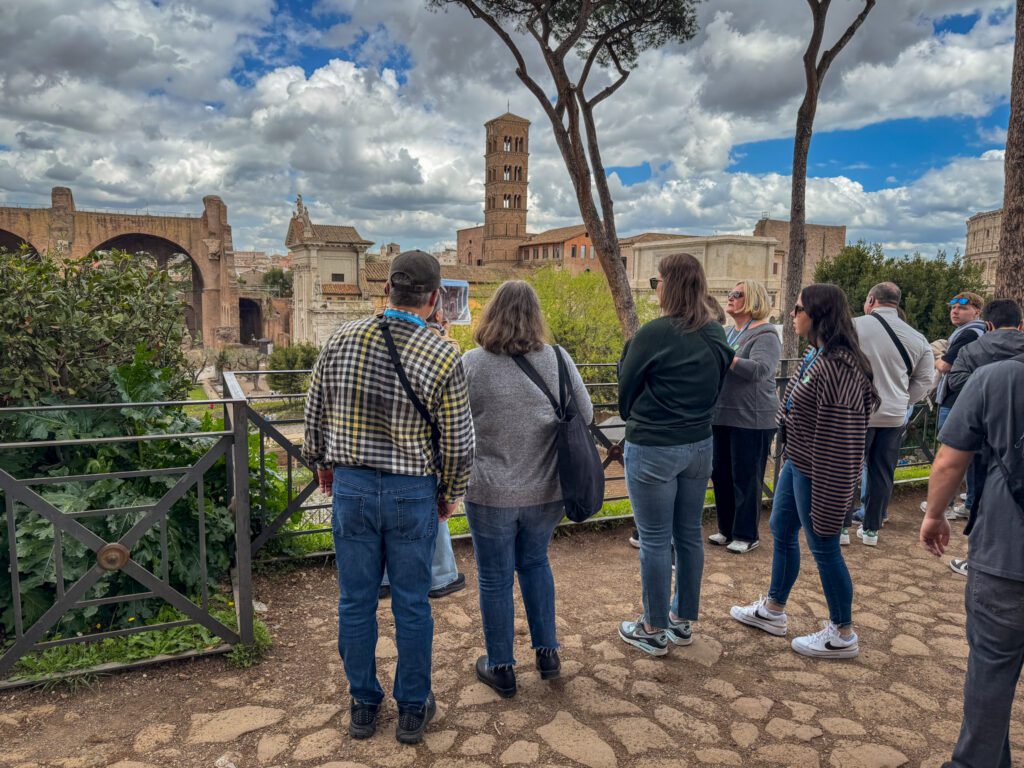
They used to have a nighttime underground tour of the Colosseum that we did a few years ago (which was fantastic because there were no crowds!), but they discontinued it.
Tips for Visiting the Colosseum & Roman Forum
Here are some tips for planning your visit that we think are important (and are based on our own experiences in the Colosseum).
Book your tickets in advance. We covered this already, but it’s worth reiterating because it’s that important. They go on sale 30 days in advance at 08:45 Central European Time (2:45am EST, 11:45pm PST).
Bring your ID (in this case, your passport). They are strict about the name on your ID matching the name on your ticket, and they will check. Make sure everyone has their ID!
Skip-the-line only allows you to skip one line, but there is a second line. If you buy them online, tickets include a fee that allows you to “skip the line.”
We’ve gotten (somewhat angry) notes from readers before who are frustrated that they still had to wait in a line, which is absolutely true.
There are two lines out front – the line for the ticket office (this is what you’re skipping) and the security line (this is what you and everyone else have to wait in) – and you get to skip the longer, slower line for the ticket office and head straight to the security line.
We love the free Rick Steves audio guides (download in advance!). I’m often a huge proponent of investing in the audio guide at art museums because it’s a good middle ground between a guided tour and just wandering around.
For the Colosseum and Roman Forum, I’d turn to the free Rick Steves guide, which is pretty good (especially for the price of free – you need to download the app in advance so you can have offline access to the guide).
Budget plenty of travel time to make it to your time slot. Traffic through the historic center is rough, which affects buses, and the metro from Termini can be SUPER busy at peak hours.
We’ve made the mistake of thinking we had plenty of time to grab the metro, entering the Termini metro station, and seeing a ticket line (for the machines) with somewhere around 100 people in it.
Walk if you can, and you’ll bypass all of that.
Prepare for heat and sun exposure, especially in the summer. While there is a little bit of shade in the Colosseum (but not much!), there is almost zero shade in the Roman Forum.
If you’re here any time between 12pm and 6pm during the summer, it’s going to be hot. Bring plenty of water, sunscreen, and plan on being extremely warm. Alternatively, book the morning or late afternoon tickets.
Don’t eat within a few blocks of the Colosseum. With very few exceptions, the restaurants around the Colosseum are something you should avoid. You’ll pay a premium for mediocre (in the best case scenario) food.
Don’t miss the viewpoints outside the Colosseum. There are a couple of good views of the Colosseum on the eastern side of the structure – namely the Giardinetto del Monte Oppio (here on Google Maps) and the Ponte degli Annibaldi (here on Google Maps). It is worth going before or after your visit to capture the grandiosity of the building!
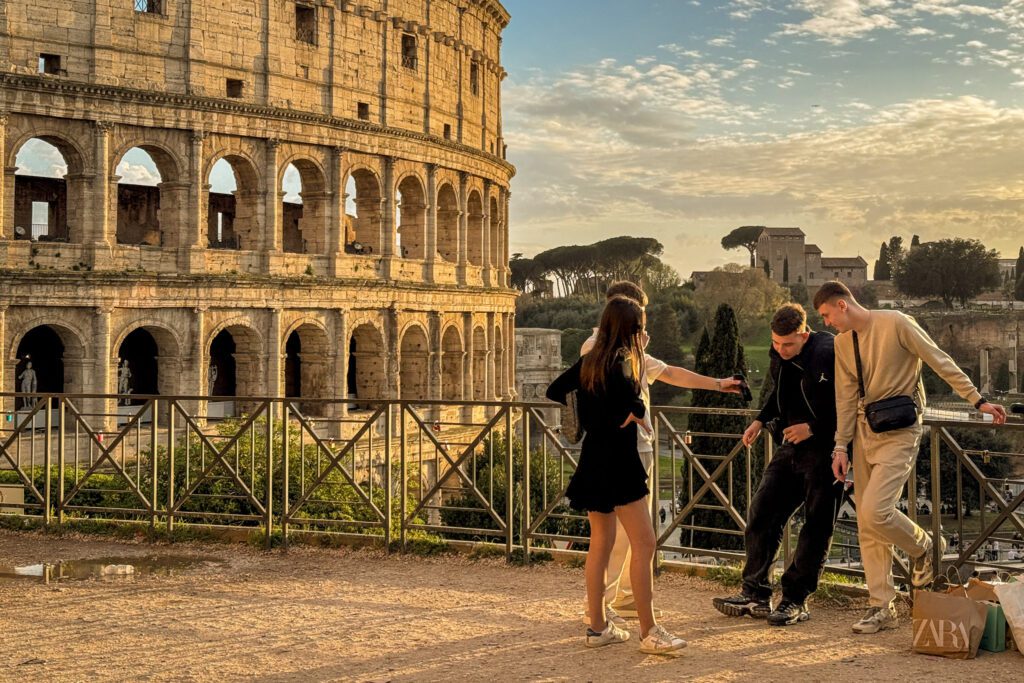
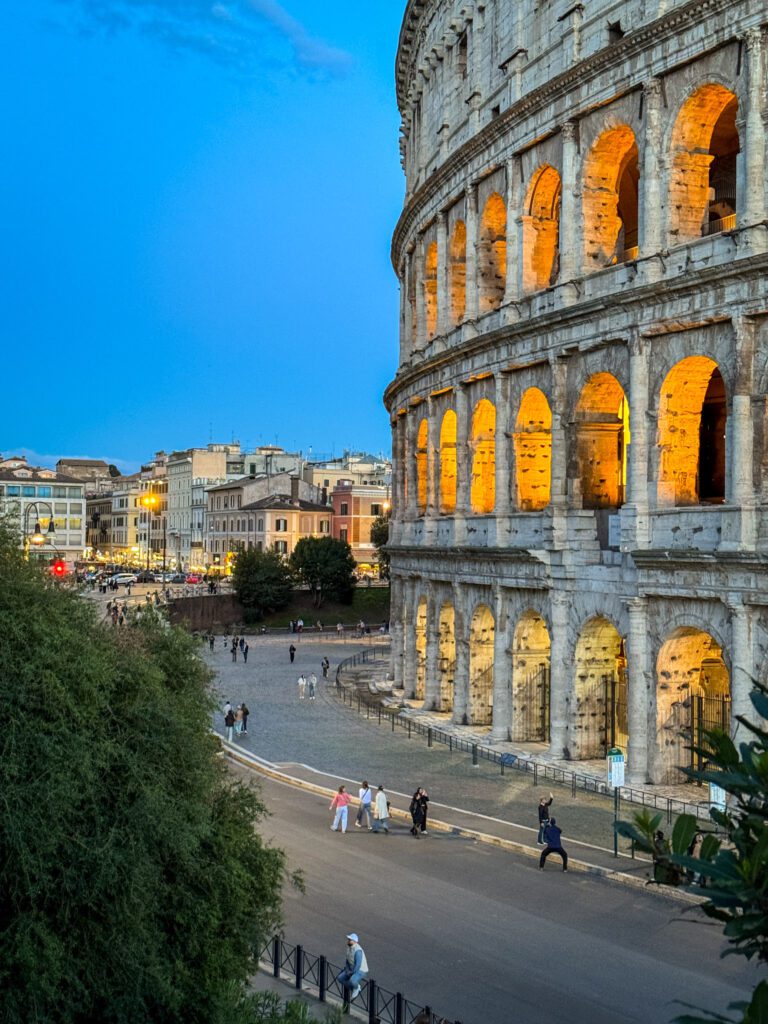
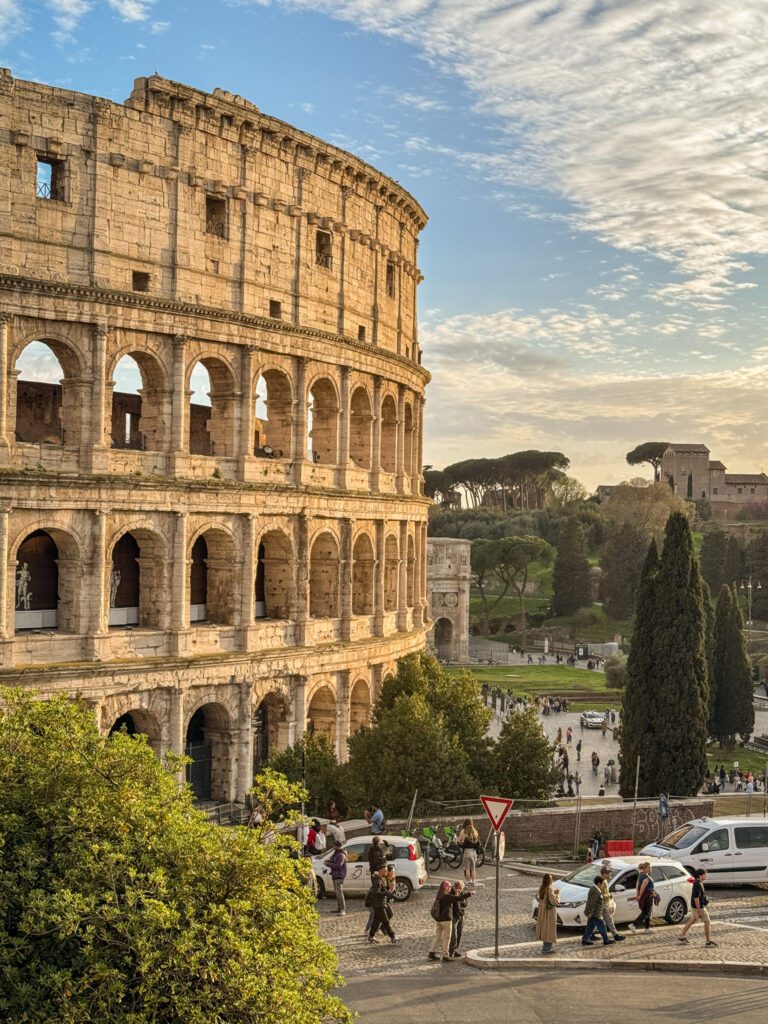
Other Things to See Near the Colosseum
Here are a few other places nearby that are worth checking out.
Piazza del Campidoglio: A pretty piazza on top of the hill that was designed by Michelangelo and features a statue of Marcus Aurelius on a horse (it’s a replica – the original is in the Capitoline Museums) as the centerpiece. Plus, a statue of the famous wolf with Romulus and Remus (which is the basis of the myth of the founding of Rome).
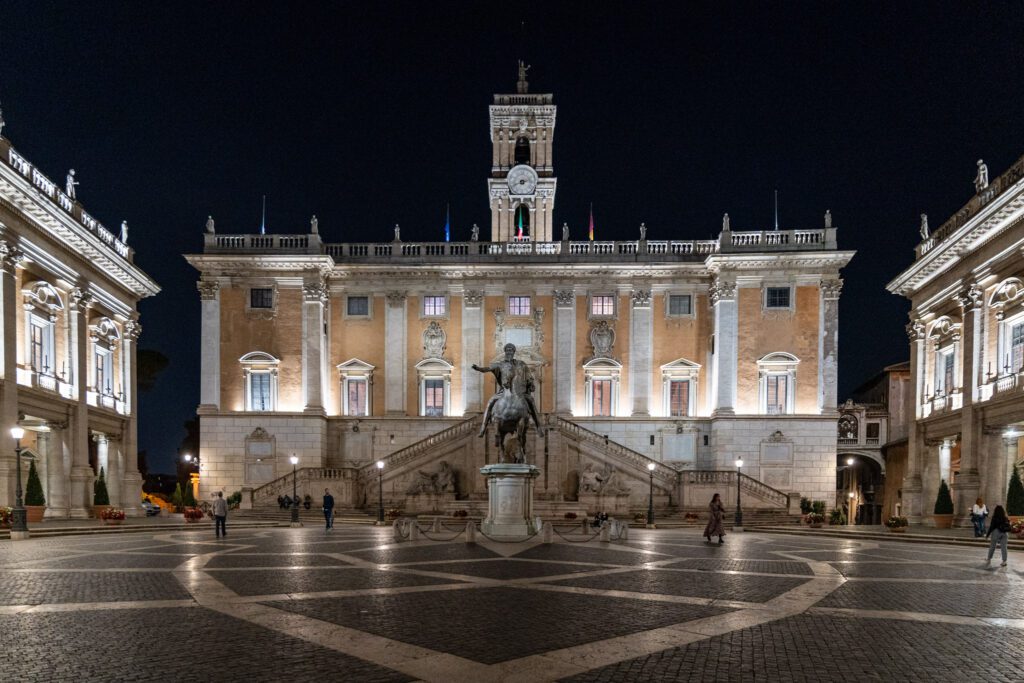
The view of the Roman Forum from above: Our favorite view of the Roman Forum is from a walkway just off of Piazza del Campidoglio, which you can find here.

Basilica of San Pietro in Vincoli: A church best known for the massive statue of Moses crafted by Michelangelo. It’s relatively unknown and free to enter.
The Circus Maximus: A short walk southwest from the Colosseum (past the Arch of Constantine) brings you to the Circus Maximus, which was once a giant race track used for chariot races and is now an urban green space full of Romans and their dogs running around (with a small museum at one end).
Planning a trip to Italy? We’d love to help!
Here are our other Italy travel guides to help you plan an incredible trip (even if you have to eat gluten free!).
If there’s no link below, it means we’re still working on it – long, in-depth guides take time! We’re working on it, though, we promise.
If you’re planning a trip and you’re not sure where to start, your first stop should probably be one of our detailed itineraries.
We have a two week Italy itinerary that blends the main cities with some less-visited cities that we love (BOLOGNA!), a guide to spending 10 days in Italy that focuses mostly on the highlights, and a whirlwind guide to spending one week in Italy that features the Rome – Florence – Venice highlight circuit.
We also have a guide covering important tips for traveling to Italy for the first time, which is a collection of things we’ve learned over the course of our time in Italy that will help you have a smoother, more immersive trip.
Here are more specific guides to the main cities in Italy.
Rome
- What to do in Rome (as a First Timer)
- How to Plan an Amazing 4 Day Rome Itinerary
- Where to Stay in Rome: A Complete Guide for First Timers
- 26 Things to Know Before You Visit Rome
- Gluten Free Rome: A Complete Guide to GF Restaurants + Bakeries
- Where to Find the Best Specialty Coffee in Rome
Florence
- What to do in Florence (as a First Timer)
- How to Plan an Amazing Florence Itinerary (3 Days)
- Where to Stay in Florence: A Complete Guide for First Timers
- Gluten Free Florence: A Complete Guide to GF Restaurants + Bakeries
- Where to Find the Best Specialty Coffee in Florence (for Coffee Nerds)
- The Best Day Trips from Florence (Complete Planning Guide)
Venice
- A Perfect 3 Day Venice Itinerary (for First Timers)
- Exactly What to Do in Venice (As a First Timer)
- Where to Stay in Venice: A Complete Guide
- Gluten Free Venice: A Complete Guide (for Foodies)
Bologna
- What to do in Bologna (as a First Timer)
- How to Spend One Incredible Day in Bologna
- How to Plan an Amazing Bologna Itinerary (2 Days)
- Where to Stay in Bologna: A Complete Guide for First Timers
Cinque Terre
- What to do in Cinque Terre (as a First Timer)
- How to Plan an Amazing Cinque Terre Itinerary (2 Days)
- Where to Stay in Cinque Terre: A Complete Guide for First Timers
Milan
- What to do in Milan (as a First Timer)
- How to Plan an Amazing Milan Itinerary (2 Days)
- Where to Stay in Milan: A Complete Guide for First Timers
- Gluten Free Milan: A Complete Guide to GF Restaurants + Bakeries
The Rest of Italy
